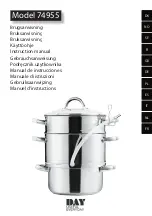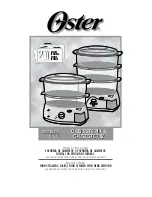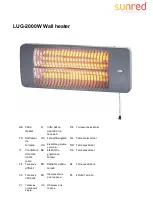
15
ENGLISH
For connection, follow the installation procedure outlined
for the commutation switch CR-25.
For the electrical connections, see the thermostat dia-
grams (TR-1or TR-2).
The TR-1 thermostat can be used with models EC-3N, EC-
5N and EC-9N.
The TR-2 thermostat can be used with models EC12N and
EC-15N. This thermostat allows an improvement in tem-
perature differential and energy savings.
OPERATION
The CR-25 commutator operates as described below.
The positions on the commutator are as follows:
0
Stop
Ventilation
Half power heating
Full power heating
When the commutation switch at the rear of the apparatus
(fi g.6) is in the position
the optional thermostat (TR-1
or TR2) acts only on the heater elements, disconnecting
them when the selected temperature is reached. The fan
functions permanently.
When the commutator is in position the thermostat acts
on the heater elements and the fan, both being disconnec-
ted when the selected temperature is reached.
The thermostat fi xes and maintains the desired tempera-
ture.
To operate, turn the thermostat control to the maximum
position.
Select the power.
Once the surrounding area has reached the desired tem-
perature, slowly turn back the thermostat control an-
ti-clockwise until a slight “click” is heard. The Aeroheater
will now connect and disconnect automatically, maintai-
ning the pre-selected temperature constant, according to
the mode selected To disconnect: Situate the commutation
switch in the “0” position.
NOTE: the surfaces of the apparatus are hot during ope-
ration.
OVERHEATING: SAFETY DEVICES
The Aeroheaters incorporate thermal protection which
prevents the apparatus from overheating by automatically
disconnecting the apparatus. This device needs to be ma-
nually reset. If the device activates, wait for 15 minutes to
allow the apparatus to cool, check that the grilles are not
dirty and, if necessary, disconnect the apparatus from the
mains supply and clean them.
To operate the apparatus again, push the RESET button lo-
cated at the top of the apparatus (fi g.7).
If the problem persists, contact S&P Offi cial Service Ne-
twork.
MAINTENANCE
• Disconnect the apparatus from the mains electricity
supply, using the mains switch, before carrying out any
maintenance operations.
• Each season, clean the accumulated dust from the inte-
rior of the apparatus using a compressed air jet to blow
through the inlet and outlet grilles. This operation should
be carried out by a qualifi ed technician.
• Regularly clean the air inlet and outlet grilles.
• Do not submerge the apparatus or place it below a tap.
• Do not disassemble or manipulate the apparatus, as this
will invalidate the guarantee.
A sensitive internal differential switch protects the applian-
ce which sometimes disconnects the apparatus from the
supply. This is normally due to the presence of humidity
in the heater elements. These elements may accumula-
te humidity in their interior when not used for long period
of time. This is not considered as a defect. To correct the
situation, connect the apparatus to the mains without the
differential switch. The drying out period could last hours
or even days. A good means to avoiding this situation is to
operate the apparatus periodically.
Note:
To ensure safe and trouble free operation is very im-
portant that the appliance is cleaned at least once a year.
Standards:
These apparatus comply with the regulations
governing radio-electrical interference, and has the requi-
red screening devices.
TECHNICAL ASSISTANCE
The extensive network of S&P Offi cial Service Agents gua-
rantees technical assistance in any place in Europe.
In the case that the product does not operate correctly,
please contact any of the previously mentioned services to
resolve the problem.
Any manipulation of the apparatus made by personnel
other than S&P Offi cial Services will invalidate the guaran-
tee.
S&P reserve the right to modify the product without prior
notice.
Summary of Contents for EC-12N
Page 1: ...EC 3N EC 5N EC 9N EC 12N EC 15N ...
Page 9: ...9 Fig 1 Fig 3 Fig 2 Fig 4 ...
Page 10: ...10 Fig 5 Fig 7 Fig 6 ...
Page 11: ...11 ...
Page 39: ......
















































